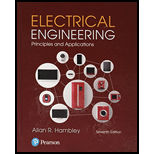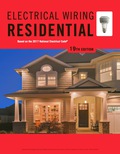
Pearson eText for Electrical Engineering: Principles & Applications -- Instant Access (Pearson+)
7th Edition
ISBN: 9780137562855
Author: Allan Hambley
Publisher: PEARSON+
expand_more
expand_more
format_list_bulleted
Question
Chapter 1, Problem 1.2P
To determine
To discuss:
Four reasons due to which students of other streams also study the fundamentals of electrical engineering.
Expert Solution & Answer
Trending nowThis is a popular solution!

Students have asked these similar questions
in the context of Noise Figure what is the gain in the formula ηs(f) = F*k*T * | H(f) |^2 is always squared?
k = Boltzmann constant
T = temperature in Kelvin
H(f) = gain of the system in question
A 6-pole, 25-Hz, three-phase, Y-connected, synchronous generator has 36 slots. There are 17 turns per
coil, and the flux per pole is 94.8 mWb. Find the line voltage if there are two parallel paths. Sketch the
placement of three-phase group coils and show the winding connections. ("
072-kVA, 208-V, Y-connected, three-phase synchronous generator delivers the rated load at 0.866 pf
lagging. The armature winding resistance is 20 mQ/phase. The core loss is 800 W. The friction and the
windage loss is 350 W. The field winding is connected across a 120-V DC source and the field current is
5.5 A. Calculate the efficiency and voltage regulation of the generator.
Chapter 1 Solutions
Pearson eText for Electrical Engineering: Principles & Applications -- Instant Access (Pearson+)
Ch. 1 - Broadly speaking, what are the two main objectives...Ch. 1 - Prob. 1.2PCh. 1 - List eight subdivisions of electrical engineering.Ch. 1 - Prob. 1.4PCh. 1 - Prob. 1.5PCh. 1 - In the fluid-flow analogy for electrical circuits,...Ch. 1 - The charge of an electron is 1.601019C . A current...Ch. 1 - The ends of a length of wire are labeled a and b....Ch. 1 - The circuit element shown in Figure P1.9 has v=12V...Ch. 1 - Prob. 1.10P
Ch. 1 - The net charge through a cross section of a...Ch. 1 - The current through a particular circuit element...Ch. 1 - The current through a given circuit element is...Ch. 1 - The net charge through a cross section of a...Ch. 1 - A copper wire has a diameter of 2.05 mm and...Ch. 1 - A certain lead acid storage battery has a mass of...Ch. 1 - A circuit element having terminals a and b has...Ch. 1 - An electron moves through a voltage of 9 V from...Ch. 1 - A typical “deep-cycle” battery (used for electric...Ch. 1 - Define the term passive reference configuration....Ch. 1 - Compute the power for each element shown in Figure...Ch. 1 - The terminals of an electrical device are labeled...Ch. 1 - The terminals of a certain battery are labeled a...Ch. 1 - The element shown in Figure P1.24 I has v(t)=10V...Ch. 1 - The current and voltage of an electrical device...Ch. 1 - Suppose that the cost of electrical energy is...Ch. 1 - Figure P1.27 shows an ammeter (AM) and voltmeter...Ch. 1 - Repeat Problem P1.27 with the meters connected as...Ch. 1 - A certain type of D-cell battery that costs $0.50...Ch. 1 - The electronics aboard a certain sailboat consume...Ch. 1 - What s a node in an electrical circuit? Identify...Ch. 1 - State Kirchhoff’s current law.Ch. 1 - Two electrical elements are connected in series....Ch. 1 - Suppose that in the fluid-flow analogy for an...Ch. 1 - Identify elements that are in series in the...Ch. 1 - Consider the circuit shown in Figure P1.36. Which...Ch. 1 - Use KCL to find the values of ia, ic , and id for...Ch. 1 - Find the values of the other currents in Figure...Ch. 1 - Prob. 1.39PCh. 1 - State Kirchhoff’s voltage law.Ch. 1 - Consider the circuit shown in Figure P1.36. Which...Ch. 1 - Use KVL to solve for the voltages va , vb, and vc...Ch. 1 - Solve for the other voltages shown in Figure P1.43...Ch. 1 - Use KVL and KCL to solve for the labeled currents...Ch. 1 - Identify elements that are in parallel in Figure...Ch. 1 - Points a, b, c, and d appear in a certain circuit....Ch. 1 - In your own words, define an ideal conductor; an...Ch. 1 - Name four types of dependent sources and give the...Ch. 1 - State Ohm’s law, including references.Ch. 1 - Draw a circuit that contains a 5 resistance, a...Ch. 1 - Repeat Problem P1.50, placing all three elements...Ch. 1 - The resistance of a certain copper wire is 0.5. ....Ch. 1 - Draw a circuit that contains a 5 resistor, a 10-V...Ch. 1 - Draw a circuit that contains a 5 resistor, a 10-V...Ch. 1 - A power of 100 W is delivered to a certain...Ch. 1 - The voltage across a 10 resistor is given by...Ch. 1 - The voltage across a 10 resistor is given by...Ch. 1 - A certain wire has a resistance of 0.5 . Find the...Ch. 1 - Plot i versus v to scale for each of the parts of...Ch. 1 - Which of the following are self-contradictory...Ch. 1 - Consider the circuit shown in Figure P1.61. Find...Ch. 1 - Consider the circuit shown in Figure P1.62. Find...Ch. 1 - Consider the circuit shown in Figure P1.63. Find...Ch. 1 - Consider the circuit shown in Figure P1.64. Use...Ch. 1 - Determine the value of Ix in the circuit shown in...Ch. 1 - Consider the circuit shown in Figure P1.66. Figure...Ch. 1 - Prob. 1.67PCh. 1 - Consider the circuit shown in Figure P1.68. Figure...Ch. 1 - Solve for the currents shown in Figure P1.69....Ch. 1 - The circuit shown in Figure P1.70 contains a...Ch. 1 - Determine the value of vx and iy in the circuit...Ch. 1 - A 10-V independent voltage source is in series...Ch. 1 - A 10-V independent voltage source is in parallel...Ch. 1 - Consider the circuit shown in Figure P1.74. Figure...Ch. 1 - The circuit shown in Figure P1.75 contains a...Ch. 1 - For the circuit shown in Figure P1.76, solve for...Ch. 1 - For the circuit shown in Figure P1.77, solve for...Ch. 1 - Match each entry in Table T1.1(a) with the best...Ch. 1 - Prob. 1.2PTCh. 1 - The circuit of Figure T1.3 has I1=3A , I2=1A ,...Ch. 1 - The circuit shown in Figure T1.4 has Vs=12V ,...Ch. 1 - We are given Vs=15V , R=10 , and =0.3S for the...Ch. 1 - We are given i4=2A for the circuit of Figure T1.6....
Knowledge Booster
Similar questions
- 11.32 A Y-D ideal three-phase transformer with a turns ratio of1 : 10 supplies a 32 kVA load at a line voltage of 208 V. Determinethe line voltage and line current at the primary sidearrow_forward11.33 A D-Y ideal three-phase transformer supplies a 32-kVAload at a line voltage of 240 V. If the line voltage at the primaryside is 51.96 V, what is the turns ratio?arrow_forwardI would like assistance with the electrical system of a streetcar/train, specifically in performing calculations related to speed, torque, and power for the motor and the train.Streetcar Gear SystemFrom my research, I have found that streetcars typically do not use traditional gear systems. Instead, the motor directly drives the truck (the assembly that holds the wheels and axles) to achieve the desired speed and torque required by the vehicle. The motor's speed and torque are controlled by a control box, which regulates the motor's performance according to the operational requirements. Truck LimitationsThe truck that will be used has certain limitations, such as: Maximun allowable speed: 50 mph Maximum motor output: 75 hp Motor specification: The specification of the motor is the following:Output power 200 HPSpeed 1150/2000 RPMArm’s voltage 600 VArm’s current 317 AFields volts 220 VField Amps 8/3Field Winding CompoundTorque calculation of the…arrow_forward
- 7. Find the currents I₁ and 12 in the following circuit, (16 points) - node V=IR 18ΚΩ 12ΚΩ RE 12 V + ww -Supernode 6ΚΩ 4k9k 12 RE22arrow_forward"Can you explain the method of choosing the direction?" Question- A plane wave in a non-magnetic medium = Нр 1 has an electric field- E = 50 sin(10®t +2)ây V m The standard equation of the electric field is- How can E = Eosin(t + Bây V m ✓ explan how (C. i)- The direction of the propagation is-âk = - âz the direction |arrow_forwardExpress this graph/signal as a sum of singularity functions. Please give a proper solution.arrow_forward
- 2) A 208 V, four-pole, 60 Hz, Y-connected, wound-rotor induction motor has a rated power of 30 HP. The components of its equivalent circuit are R1 = 0.100 R2 = 0.070 XM = 10.0 X1 = 0.210 X2 = 0.210 Pmec = 500 W Psup ~ 0 Pcore = 400 W For a slip of 0.05, find: a) The line current b) The stator copper losses PcE c) The air gap power PEF d) The power converted from mechanical to electrical form Pconv e) The induced torque _ind f) load torque _load g) The total efficiency of the machine h) The speed of the motor in revolutions per minute and in radians per secondarrow_forward5. There are three sources that would affect the current flow in this circuit. Find the current through the 4k2 resistor that is caused solely by the 24V source (i.e., remove the 2mA and 12V sources using the correct methods). (20 points) 24 V + 9k, ww www 4kS 2mA 24ΚΩ www ++ 12V www 6k 24ΚΩarrow_forward"Can you explain the method of finding the direction?" the electric field in free space is given by ety E: 50 Cos [2π 10 t - Bz ] a) find the direction of the wave propagation b) Calculate W, B, A, S V/marrow_forward
- Athle phase a.c. distributor AB has: The distance from A to B is 500 m. The distance from A to C is 800 m. The impedance of each section is (6+j 8) /km. A B C The voltage at the far end is maintained at 250 volt. Find: sending voltage, sending current, supply power factor and 80 A 60 A total voltage drop. 0.8 lag. P.f 0.6 lead. p.farrow_forwardThe transfer function H(s) = Y(s)/X(s) = Vo(s)/Vi(s) should be found from the circuit given that the initial conditions are equal to 0. Do not answer using AI Chatbots. PLEASEarrow_forwardA 10kW, 230V, long shunt compound DC generator has efficiency = 82%, armature resistance = 0.15 ohms, series field resistance = 0.1 ohm, shunt field resistance = 100 ohms. What are: armature current, armature voltage across the brushes, generated emf, total copper losses, and horsepower of prime mover?arrow_forward
arrow_back_ios
SEE MORE QUESTIONS
arrow_forward_ios
Recommended textbooks for you
 EBK ELECTRICAL WIRING RESIDENTIALElectrical EngineeringISBN:9781337516549Author:SimmonsPublisher:CENGAGE LEARNING - CONSIGNMENT
EBK ELECTRICAL WIRING RESIDENTIALElectrical EngineeringISBN:9781337516549Author:SimmonsPublisher:CENGAGE LEARNING - CONSIGNMENT

EBK ELECTRICAL WIRING RESIDENTIAL
Electrical Engineering
ISBN:9781337516549
Author:Simmons
Publisher:CENGAGE LEARNING - CONSIGNMENT